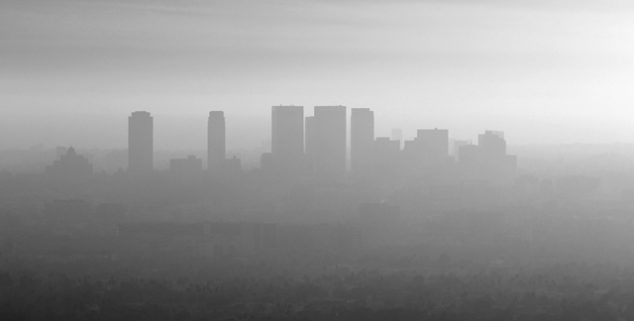News
The utilities’ new electric transportation infrastructure
 A black-and-white view of smoggy Century City, Beverly Hills and West Los Angeles. (Photo: trekandshoot)
A black-and-white view of smoggy Century City, Beverly Hills and West Los Angeles. (Photo: trekandshoot)Squinting into the smog, our state’s utilities have seen the future—and it’s not fossil fuels.
On the same day the nation inaugurated a president firmly entrenched in 19th century energy technology, three California power companies catapulted the industry into the future with a plan for a new clean energy paradigm. It’s one of many signs that Californians are not only holding the line, but pushing into new territory to protect our environment and our health.
Environmental justice voices have been asking for zero emission technologies to clean up our ports, rail yards, bus depots and warehouses.
Southern California Edison, Pacific Gas & Electric and San Diego Gas & Electric revealed plans to invest $1 billion to build a comprehensive electric transportation infrastructure designed to reduce air pollution, curtail production of greenhouse gases and modernize transportation in every aspect from personal commutes to the state’s giant diesel-powered freight industry.
The plans, which must now be approved by the California Public Utilities Commission, include extending power to electric charging stations at warehouses and bus yards; electrifying forklifts, trucks and other equipment at our ports; installing fast charging sites in parking lots near airports, apartment complexes and shopping malls; and creating incentives for electric vehicles for taxi drivers, ride-share programs and everyday use by families.
Southern California Edison’s plans in particular help push the ball down the field in moving to a truly modern transportation system. When they did the math, they found the estimated costs for their current proposal for electricity customers to be about 53 cents a month. In contrast, healthcare experts estimate the annual financial burden for a patient with well-controlled asthma is $450, while the most severe asthma cases can cost families over $14,000 a year. We need more investments even quicker in places like the Los Angeles region, given the health and environmental imperative to clean up our transportation system.
Beyond the financial calculations of healthcare and lost workdays, good health is truly priceless. Six of the nation’s 10 cities with the highest ozone and particulate pollution are in California. Nearly three million Californians have asthma. The benefits of zero emissions freight and transportation to people living in the state with the nation’s worst air pollution problems are incalculable – for families, a child with a healthy set of lungs means so much more than healthcare savings.
That’s why for more than a decade environmental justice voices have been on the forefront of this issue, asking for zero emission technologies to clean up our ports, rail yards, bus depots, and warehouses.
Many of those most at risk in California live in low-income neighborhoods near ports and industrial areas where diesel engines are concentrated, making air quality a life-or-death environmental justice issue. In particular, transforming the machinery and transportation equipment at California ports, which are among the largest in the world, will have enormous benefits for our state’s air quality.
The utilities’ plan rightly rejects proposals to build out our dependence on natural gas. The natural gas industry has tried to market its products as a “bridge fuel” to a clean grid for our state. But natural gas is still a fossil fuel, and problems with leaks, explosions, and the devastating well blowout at the gas storage facility in Aliso Canyon make it clear that electrification is a better investment.
And while the utilities are exhibiting admirable foresight, the transportation electrification plans clearly demonstrates the importance of tough legislative action. The plans were a direct response to Senate Bill 350, which calls for 40 percent reductions in greenhouse gas emissions from 1990 levels by 2030.
Under the 2015 law, which spurred difficult policy discussions in Sacramento, the utilities are required to develop plans to meet the clean energy goals and specifically to “accelerate widespread transportation electrification.”
Despite the criticism of laws like SB 350 from opponents who have predicted major environmental progress on air quality and climate change would “cripple the state,” we’re seeing the seedlings of a massive investment in infrastructure that is going to put Californians to work in the clean energy economy.
Building the Golden State’s grid of electric transportation, freight, and charging stations – all powered by renewable energy – will be a cost effective investment that promises long-term benefits for the health of Californians. We’re on the right side of history for our children, our lungs, and our communities – and the future is electric.
—
Ed’s Note: Adrian Martinez is a litigator at Earthjustice working on behalf of communities for clean air.
Want to see more stories like this? Sign up for The Roundup, the free daily newsletter about California politics from the editors of Capitol Weekly. Stay up to date on the news you need to know.
Sign up below, then look for a confirmation email in your inbox.

Leave a Reply